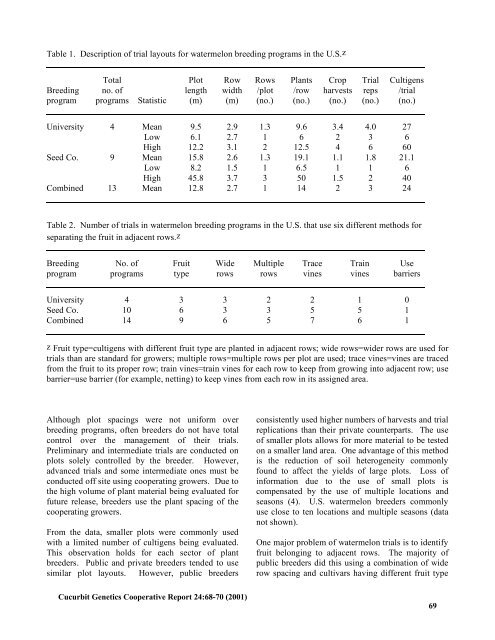Complete volume with articles 1 to 35 - Cucurbit Breeding - North ...
Complete volume with articles 1 to 35 - Cucurbit Breeding - North ...
Complete volume with articles 1 to 35 - Cucurbit Breeding - North ...
Create successful ePaper yourself
Turn your PDF publications into a flip-book with our unique Google optimized e-Paper software.
Table 1. Description of trial layouts for watermelon breeding programs in the U.S.z<br />
Total Plot Row Rows Plants Crop Trial Cultigens<br />
<strong>Breeding</strong> no. of length width /plot /row harvests reps /trial<br />
program programs Statistic (m) (m) (no.) (no.) (no.) (no.) (no.)<br />
University 4 Mean 9.5 2.9 1.3 9.6 3.4 4.0 27<br />
Low 6.1 2.7 1 6 2 3 6<br />
High 12.2 3.1 2 12.5 4 6 60<br />
Seed Co. 9 Mean 15.8 2.6 1.3 19.1 1.1 1.8 21.1<br />
Low 8.2 1.5 1 6.5 1 1 6<br />
High 45.8 3.7 3 50 1.5 2 40<br />
Combined 13 Mean 12.8 2.7 1 14 2 3 24<br />
Table 2. Number of trials in watermelon breeding programs in the U.S. that use six different methods for<br />
separating the fruit in adjacent rows.z<br />
<strong>Breeding</strong> No. of Fruit Wide Multiple Trace Train Use<br />
program programs type rows rows vines vines barriers<br />
University 4 3 3 2 2 1 0<br />
Seed Co. 10 6 3 3 5 5 1<br />
Combined 14 9 6 5 7 6 1<br />
z Fruit type=cultigens <strong>with</strong> different fruit type are planted in adjacent rows; wide rows=wider rows are used for<br />
trials than are standard for growers; multiple rows=multiple rows per plot are used; trace vines=vines are traced<br />
from the fruit <strong>to</strong> its proper row; train vines=train vines for each row <strong>to</strong> keep from growing in<strong>to</strong> adjacent row; use<br />
barrier=use barrier (for example, netting) <strong>to</strong> keep vines from each row in its assigned area.<br />
Although plot spacings were not uniform over<br />
breeding programs, often breeders do not have <strong>to</strong>tal<br />
control over the management of their trials.<br />
Preliminary and intermediate trials are conducted on<br />
plots solely controlled by the breeder. However,<br />
advanced trials and some intermediate ones must be<br />
conducted off site using cooperating growers. Due <strong>to</strong><br />
the high <strong>volume</strong> of plant material being evaluated for<br />
future release, breeders use the plant spacing of the<br />
cooperating growers.<br />
From the data, smaller plots were commonly used<br />
<strong>with</strong> a limited number of cultigens being evaluated.<br />
This observation holds for each sec<strong>to</strong>r of plant<br />
breeders. Public and private breeders tended <strong>to</strong> use<br />
similar plot layouts. However, public breeders<br />
<strong>Cucurbit</strong> Genetics Cooperative Report 24:68-70 (2001)<br />
consistently used higher numbers of harvests and trial<br />
replications than their private counterparts. The use<br />
of smaller plots allows for more material <strong>to</strong> be tested<br />
on a smaller land area. One advantage of this method<br />
is the reduction of soil heterogeneity commonly<br />
found <strong>to</strong> affect the yields of large plots. Loss of<br />
information due <strong>to</strong> the use of small plots is<br />
compensated by the use of multiple locations and<br />
seasons (4). U.S. watermelon breeders commonly<br />
use close <strong>to</strong> ten locations and multiple seasons (data<br />
not shown).<br />
One major problem of watermelon trials is <strong>to</strong> identify<br />
fruit belonging <strong>to</strong> adjacent rows. The majority of<br />
public breeders did this using a combination of wide<br />
row spacing and cultivars having different fruit type<br />
69

















